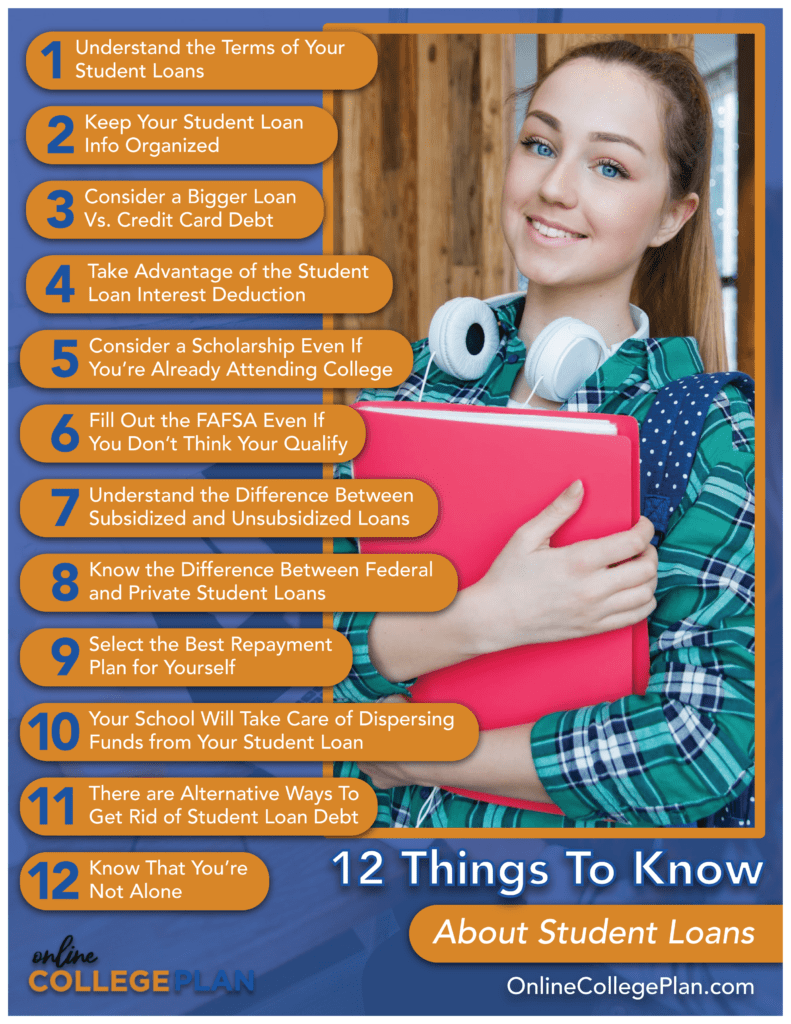12 Things to Know About Student Loans
Find your degree

Student loans to help you pay for college may seem simple, but first impressions can deceive. They are actually more complex than most people think, with many aspects that aren’t well understood. Since it can be time-consuming to dig deep into every technicality, we’ve compiled a dozen of the most important facts you need to know about student loans.
While you won’t walk away from this article as an expert in college lending, you should have a fairly good grasp on the most vital details if you pay attention. Read on for the specifics.
Understand the Terms of Your Student Loans
The first thing that college graduates need to know about their student debt is the terms of each of their loans. Here are a few important things that you will want to find out:
• Whether your student loans are federal or private.
• The interest rates on your respective loans, so you can calculate your average interest rate.
• Your minimum monthly payment.
• The date you must start repaying your debt.
If you fully understand your obligations as a student loan borrower, then you will avoid making mistakes—mistakes that can cost you big, like missing payments. Furthermore, it will enable you to create a good plan to pay off your loans in a timely manner.
This brings us to our second most important thing to know about student loans: you need to get organized.

Keep Your Student Loan Info Organized
If you’re like many students, you could have multiple loans, each with different payments and due dates, and that’s not even counting your typical household bills and other expenses. If you don’t keep your loan information organized, you’ll be putting yourself under a lot of unnecessary stress, not to mention you risk defaulting on a payment and damaging your credit.
While setting up a system can take a bit of time, it can definitely save you from a disaster down the road. Since organization means different things to different people, your system will be unique, but basically you should start with a spreadsheet (or even a piece of paper) and list out the following details:
• Type of loan
• Interest rate
• Date the loan originated
• Total amount to pay off
• Status of the loan (active, or in deferment, forbearance, or a grace period)
• Monthly payment amount
• Monthly due date
• Name and contact information for the lender
You should also keep all your loan-related paperwork and documents in a specific place. For hard copies, you can separate the documents you receive from each lender into manilla folders. If you have digital copies, organize them on your PC into virtual folders. Be sure to label things clearly to make them easy to find when you need them.
Another way to get organized is to keep track of your login details. With so many passwords and usernames, things can get confusing fast. Store this information in one secure document or use a password manager to make things easier on yourself.
Consider A Bigger Loan vs. Credit Card Debt
Students often borrow money in excess of customary attendance costs like room, board, tuition, and books to pay for things not related to education. Sometimes this makes sense. After all, everyone has incidental expenses, and haircuts, personal care items, gifts, clothing, and other necessities don’t just pay for themselves. If you aren working because your time is spent pursuing your degree, how will you handle these personal expenditures?
All funds you borrow will eventually need to be repaired. But consider this: if you’re thinking about using credit cards to fill in the gap, a better choice may be to take on more student loans.
There. We’ve said it. It may run counter to what you’ve been taught about personal finance, but If you’re going to be saddled with debt anyhow, you’ll want to choose the option with the lowest interest rate. The average interest rate on a credit card is 16 percent. When you consider that many student loans (both public and private) have less than seven percent interest rates, it’s really a no-brainer.
Still, no matter how much you borrow, you’ll need to repay it, eventually. And that day will come faster than you expect. If you’re planning on paying off your loans based on what you are likely to earn down the road, think about how much you will be able to afford each month. Tools like the Debt/Salary Wizard on Mapping Your Future can help.

Take Advantage of the Student Loan Interest Deduction
If your adjusted Gross Income (AGI) is less than or equal to $70,000 (for singles) or $140,000 (for married couples), you can deduct up to $2,500 each calendar year in interest paid on an eligible student loan. There is no need to itemize this deduction as it will show as an adjustment to income on Form 1040.
Your lenders can show you a summary of interest paid for each tax year. If you paid $600 or more in interest to a lender, they are required to send you Form 1098-E as documentation. But if you paid less to a specific lender, you might need to track down the amount yourself. This is where good record-keeping comes in handy.
To qualify, your school needs to be on the eligible institution list, and you need to be enrolled at least half time. The related loan must also be one used for qualified educational expenses.
Consider a Scholarship Even If You’re Already Attending College
Scholarships are not just for students starting their first year of college. Second, third, and even senior year students may be eligible for a scholarship or grant.
If you’re getting good grades, see if your school rewards high achievers. The same goes for students currently excelling in sports or the arts. Merit-based scholarships like these are often overlooked by current students.
Maybe your financial situation has gotten more difficult since you first arrived at school. If so, you may qualify for a need-based scholarship that you were not eligible for before.
If you finally know what you want to focus on, scholarships that are specific to your major may be available. This is especially true for high-need fields like nursing and education, but there are plenty of other major-specific scholarships too. You just might need to do a little digging.
If you identify as a minority student, you’ll find more scholarships available than ever before. Women students, too, can find unique scholarship opportunities.

Fill Out the FAFSA Even If You Don’t Think You Qualify
Many people skip over the FAFSA because they assume they won’t get any financial aid. But college is expensive. Even if there’s a small chance you could be awarded some assistance, shouldn’t you at least try?
Plus, you never know when your circumstances could change. If something happens mid year that affects your finances, you’ll be glad of having your FAFSA filled out and submitted already.
At some schools, unless you fill out a FAFSA, you won’t qualify for merit aid. So if you’re hoping to be awarded based on academic achievement or some other area of excellence, fill out the FAFSA paperwork just to be safe. You may even be eligible for special scholarship offers, even if you aren’t awarded anything based on need.
Understand the Difference Between Subsidized and Unsubsidized Loans
There are two types of federal loans: those that are subsidized and those that are unsubsidized. Understanding the difference is critical.
Undergraduates are eligible to apply for either of these loans, and for both of them, the federal government sets a fixed interest rate. You don’t need a certain credit score to qualify, although you do need to complete the FAFSA.
Subsidized loans are awarded to students who can demonstrate financial need based on some specific criteria. As long as you remain in school at least part time, the government pays the interest on your loan. You don’t need to start paying it back until six months after you leave college. The amount you borrow cannot exceed your financial need, which will be determined by your school.
Unsubsidized loans are for all students, even those who cannot demonstrate financial hardship. However, unlike subsidized loans, interest begins accruing on unsubsidized loans as soon as you take them out. This means you are responsible to pay the interest even while still in school. If you can make the payments, they are added to the principal and could make your overall cost a lot more in the end.

Know the Difference Between Federal and Private Student Loans
Federal student loans are offered through the government, whereas private student loans come from a bank, credit union, or other private-sector funding source.
It is hard to disagree that a federal student loan is the better option. Currently, interest rates are low at 2.75 percent for Undergraduates and 4.30 percent for Professional or Graduate students. Moreover, these rates will remain fixed and are often lower than rates for private loans.
Since a hard credit check is typically not necessary when applying for a federal student loan, students with poor credit or those without a solid credit history will find it easier to qualify.
Private student loans can have higher fixed rates or variable rates and most require a decent credit score to qualify. You may be required to start making payments while still attending school, and there could be prepayment penalties if you want to pay them off earlier.
With private loans you will typically be responsible for all the interest on the loan, and it can be difficult to postpone or lower your payments if you suddenly experience financial hardship.
So why would anyone choose a private loan over a federal student loan?
Occasionally, students with great credit can get a lower interest rate on a private loan, especially those pursuing advanced degrees. Also, in some cases, the loan limit is higher, allowing students to borrow more. If you aren’t able to borrow enough through a federal student loan, a private loan may help fill the financial gaps.
In some cases, you may have maxed out the amount you qualify for with a federal loan. In this situation, it can make sense to apply for private funding.
In virtually all cases, it is more appropriate to use federal loans first, and private loans as a backup plan.
Select the Best Repayment Plan for Yourself
Unfortunately, if you have private student loans, you will pretty much have to stick to the original repayment plan that you agreed to when taking out your loans. However, if you hold federal student loans, you have more flexible repayment options:
• Standard repayment plan where you will pay off your loans in 10 years.
• Various income-driven plans that cap your monthly payment at either 10 or 15 percent of your disposable income. Any remaining debt is forgiven after either 20 or 25-years, depending on the repayment plan.
• A graduated repayment plan where your payments start small and gradually rise until the loans are paid off after 10 years.
The repayment plan you choose will determine your monthly payment and how long you will have until you become debt-free. Therefore, make sure you weigh all the pros and cons of each plan to select the best one for you.

Your School Will Take Care of Dispersing Funds From Your Student Loan
Once you have signed your student loan paperwork and you’ve been approved, your school will take care of the rest. This is true whether you are receiving a federal loan or a private one, so there is no need to be concerned about how to get the money to the appropriate departments.
Everything will be processed through your school’s financial aid office. First it is applied to your account to cover your fixed educational expenses like tuition, on-campus housing, fees, and meal plans. Whatever is left over will be refunded to you for your other expenses.
Be aware that the leftover funds are intended to be used for things that directly tie in to you pursuing your education such as basic living expenses, school supplies, and books. You can’t use the money to take a vacation or buy a new TV, for example.
Also keep in mind that you will eventually need to pay it all back. So if your refund ends up being more than you need, consider using the extra to pay down the loan right away.
There Are Alternative Ways To Get Rid of Student Loan Debt
If you’re willing to do a little creative research, you will discover all kinds of interesting ways to unload some (or all) of your student loan debt, including:
Federal Student Loan Forgiveness
Federal student loan borrowers who work in an eligible government or nonprofit position can apply to have their student loans forgiven after 10 years of payments. The program is called Public Service Loan Forgiveness. You will need to make sure that you have filled out all the right paperwork and selected the correct repayment plan to qualify.
Career Related Grants
A career based grant typically works like this: You agree to work for an organization in a high-needs field or community for a specified amount of time after graduation. In return, the organization rewards you by paying off all or part of your student loan debt.
This type of program is not for everyone, but for those who were planning on this type of work already, it can be a win/win. The most common career-based grant programs can be found in the healthcare, education, legal, and research fields.
In an effort to attract bright young minds to specific regions, some states themselves offer a similar deal. This is particularly true for students pursuing STEM professions. It’s worth it to check around, especially if you have a passion for a specific area of the country.
Employee Benefit Grants
In recent years, some companies have begun offering student loan repayment plans as part of their employee benefit packages. Usually, it is a monthly benefit over a certain number of years with the company. Many times, the employer will match the employees loan payment up to a certain amount.
While there is usually an upper limit to the benefit, it can definitely help you shave a few years off your loan payments.

Know That You’re Not Alone
When you’re stressed about student loan debt, the burden can feel isolating—as if you’re the only person in this predicament. But the truth is that while they might not vocalize their concerns, thousands of other students share your experience.
In 2020, students owe over $1.67 trillion. The average college graduate leaves school with over $29,000 in loans. Student debt outpaces credit card debt and even auto loans. In fact, the only people that owe more money than students are those who have a mortgage! It’s no wonder that students are stressed. It can be tough to learn with these statistics looming.
The good news about these numbers is that you can stop thinking you’re the only one with mountains of college debt. Plus, it may not be as bad as you think. If student loans are affecting your stress levels, there are some helpful tools available on the US Federal Student Aid website that might help you take action towards some financial relief.

Final Thoughts
Whether you’re an incoming college freshman, you’re in the middle of your education, or you’ve recently left school as a student loan borrower, repaying that debt will be a big part of your post-college reality.
Make sure you fully understand your student loans so you can make the right decisions and come up with the best options for financing your education.
Related:
